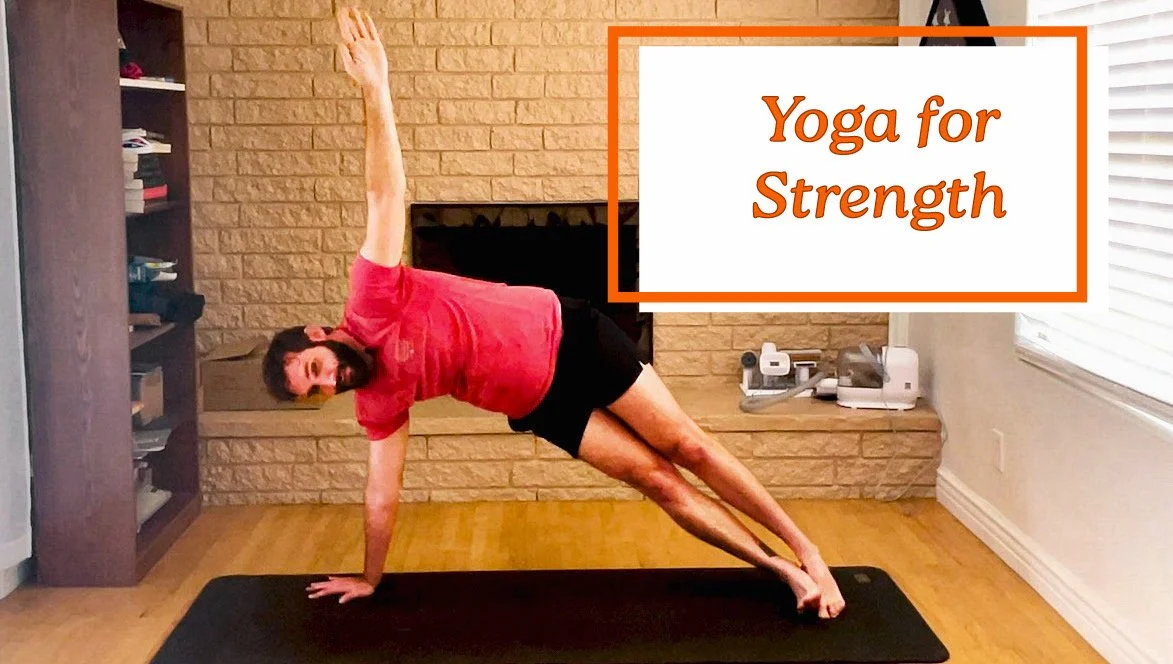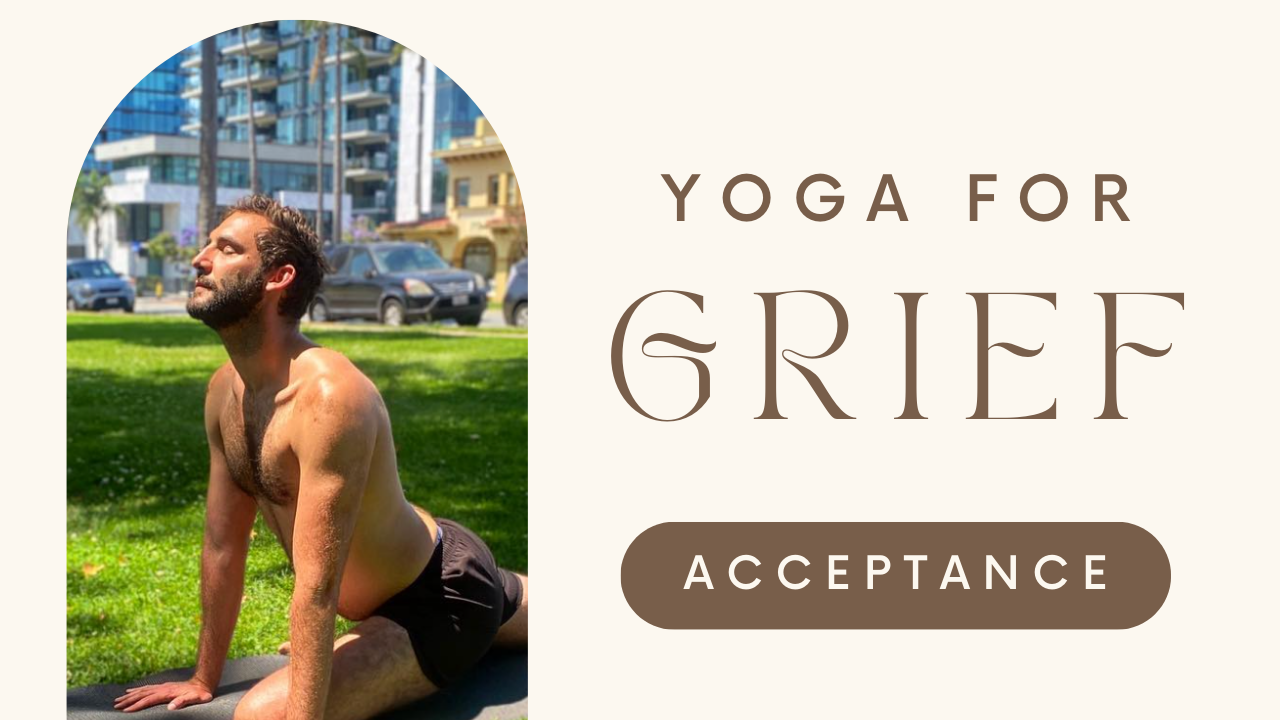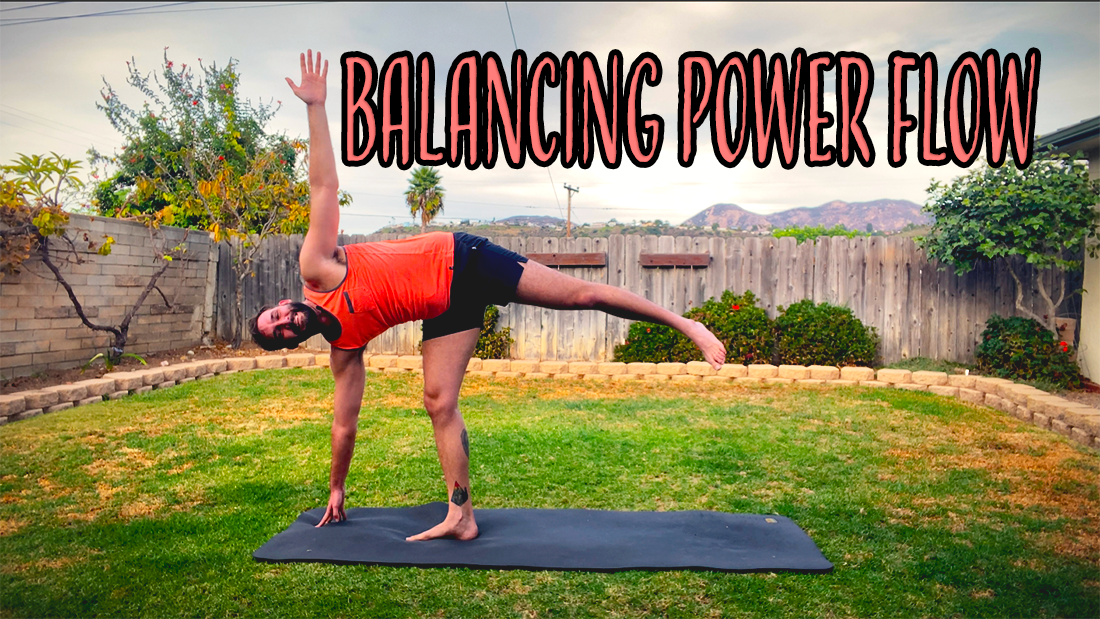Yoga Flow to Build Strength
Join me for a sweaty vinyasa flow designed to increase your strength, focus, and endurance. invigorating Power Yoga Flow designed to enhance your balance, strength, and flexibility!
Join me for a sweaty vinyasa flow designed to increase your strength, focus, and endurance. invigorating Power Yoga Flow designed to enhance your balance, strength, and flexibility!
In this dynamic session, I'll guide you through a series of deep hip-opening postures as we build strength through planks and connect our breath to our movement.
What to Expect
Strong Flow: Connect your breath to movement with some challenging and mindful vinyasa moves that will create heat and build strength in your body.
Mindful Movement: As always, show up for yourself as best as you can. There may be some things you struggle to do, and that’s okay. You may also sail through the practice in a breeze, and that’s also okay. Just be mindful as you explore, wherever you are.
Whether you're looking to challenge yourself or just continue to grow your physical practice, this vinyasa flow is all you'll need.
See you on the mat!
Yoga for Grief: Acceptance
The last thing you’re likely thinking about during your grief process is anything to do with joy or happiness. Depending on where you are in your journey or whether you’ve gone through any of the other grief yoga videos, you may be more willing to start moving forward into that sense of healing. You also may not, which is equally okay, but it’s what we’ll look at today anyway.
“The acceptance of death gives you more of a stake in life. In living life happily, as it should be lived. Living in the moment.”
A Recap From Yoga for Grief: Acceptance
The last thing you’re likely thinking about during your grief process is anything to do with joy or happiness. Depending on where you are in your journey or whether you’ve gone through any of the other grief yoga videos, you may be more willing to start moving forward into that sense of healing. You also may not, which is equally okay, but it’s what we’ll look at today anyway.
Yin yoga can be just as challenging, if not more, than a vinyasa practice. In vinyasa, as in life, we’re so used to moving from breath to breath, posture to posture, thing to thing. We aren’t used to slowing down and just being present. We dabbled in that a little bit with our depression practice, but we’re in full force with our yin today.
Our bodies store a lot more emotions than we think or give them credit for, particularly in our hips. Many people feel emotional after a deep yin practice because they find they’ve awakened emotions they otherwise considered dormant, and can sometimes be caught off guard by that.
Awaken all the good, bad, and ugly within you.
This is grieving. It isn’t supposed to be pretty. Other people around you aren’t supposed to understand. It isn’t meant for them to understand. It’s meant for you to explore on your own. I’ve set it before but I will say it again, the more you spend time in denial of your feelings, the more angry you’re likely to get, and that won’t help anything, either. You can wonder why this is happening as much as you want, but ultimately, that won’t change a thing.
Fortunately, you’ve shown up for yourself. Maybe it was just for this practice, or maybe you’ve done all of the others in the grief series as well. Be proud of anything you’ve done to explore and connect deeper with your body, your mind, and your emotions, and remember that this journey is not linear and will take constant work.
For further breathwork off the mat, consider the Three-Part breath
The Three-Part Breath, also known as Dirgha Pranayama or the “Royal Breath,” is a very simple, easy, basic, and effective form of breathwork. It’s very frequently used as the first form of breathwork to teach new practitioners, and it’s one of the easiest ones to accomplish.
Sit or lay comfortably and exhale all of your breath. The three parts here are your abdomen, your diaphragm, and your chest. You can either slowly inhale and feel all of these parts of you fill up, or take a small inhale and breath into your abdomen, pause there, then inhale into your diaphragm, pause, and then finish your inhale at the top of your chest. This breaks the breath into the three parts, and even though there are pauses in each section, it is still all done within the same inhale. The same goes for the exhale, either nice and smooth as you deflate or breaking it up into the three parts to let it all go.
If you’re seeking a journal entry, reflect on how your grief has changed you
Wherever you are on your grief journey, you’re not the same person you were before it. It doesn’t matter if the changes you feel are life-altering or minuscule — you’re still different. Take some time to reflect on that. What were you like before this happened to you? What about it has changed for you, and how will you go about incorporating this into your life?
I know it’s hard. Trust me, I do. There’s a link to the grief retreat below, and I am always here if you need anyone to talk to as you move through your journey.
Stay safe and heal well, my friends.
Be sure to check out other Yoga for Grief videos, and if you’re interested in booking the 2024 Yoga for Grief retreat, do so before tickets sell out!
WHAT ARE YOU GRIEVING OR WORKING TO LET GO OF? LET ME KNOW DOWN IN THE COMMENTS! ALL ARE WELCOME HERE.
Yoga for Grief: Anger
Today, we tapped into our rage on the mat and worked to “punch out” the feelings that we’re going through. We moved through some punches and kicks incorporated with our yoga poses to tap into the rage we’re feeling but then to settle back into the experience as we returned to the poses and postures.
“For every minute you remain angry, you give up sixty seconds of peace of mind.”
A Recap From Yoga For Grief: Anger
The most common emotion people openly admit they’re feeling during the grieving stage is anger. They may not open the conversation with the rage they’re feeling, but anger is easy to feel and a very dominating presence when it’s there. You may be mad at God for letting it happen. You may be mad at the person for dying, even if they didn’t do it on purpose. Or you may be mad at your ex for leaving you, your boss for letting you go, or any other number of reasons that make you feel like punching a hole through the wall or kicking something that will shatter after your foot makes contact with it. You may also still be in denial about what’s happening, wondering why it happened to you, depressed over your situation, or maybe working toward a better place of acceptance. This is why the grief yoga practice is here for you.
Today, we tapped into that rage on the mat and worked to “punch out” the feelings that we’re going through. We moved through some punches and kicks incorporated with our yoga poses to tap into the rage we’re feeling but then to settle back into the experience as we returned to the poses and postures.
Throughout the practice, our main focus of breathwork was on “Breath of Fire.” This breath had a lot of attention throughout the day, as it is a type of breathing associated with stress relief, as well as helping the overall health of our breathing. It is done by forced and quick exhales followed by natural and short inhales that come out of your nose in a short staccato rhythm as directed by your diaphragm.
Today, You Were Meant to Feel Your Anger.
Look, I get it, this can be the hardest thing to do. Actually, when it comes to feeling angry, when that anger mixes in and is influenced by grief, it is a rage unlike anything else you’ve ever experienced. It’s scary. It’s raw. It’s visceral, it’s real, and it feels like you swallowed a knife that’s been sitting in a fire that winds up coming alive in your stomach and eating you from the inside out. Honestly, it’s probably the last emotion you actually want to feel.
It, however, will also likely be the loudest emotion you’ll have. If you’ve never felt like an actual emotion was screaming at you, you’ve never felt the rage associated with grief. You want to claw your skin off your body and destroy everything in sight. It removes any semblance of “sense” and replaces it with confusion and adds to the loss.
As scary as it is to feel, though, the more you suppress it, the worse it will end up being in the end.
For Further Breathwork off the Mat, Consider Keeping The Breath Of Fire
The Breath of Fire causes heat within your body and helps keep your blood purified while keeping your energy levels high. Contracting your belly also massages your internal organs, which can help improve digestion and increase your immune system.
A slightly different practice is Kapalabhati. With Breath of Fire, the quick pace and rhythm of your exhales an inhales are the same. With Kapalabhati, there are short, vigorous exhalations are longer than your inhales, which become passive.
Practicing this outside of your mat or before or after a meditation will also help bring your awareness more inward.
IF YOU’RE SEEKING A JOURNAL ENTRY, WRITE ABOUT Where in Your Body You Feel Your Anger.
We don’t always think about where in our body we feel emotions. Whenever I ask people where they’re feeling certain emotions, it’s always interesting to me the different answers people give. Some feel sadness in their shoulders, joy in their stomach, anger in their chest. We actually carry a lot more emotions and trauma in our hips than we give ourselves credit for, which is why doing hip-opening postures can bring up so many emotions.
For a journaling activity today, write about where you feel your anger. You can also write about any other feelings you have, of course, but since we’ve been focusing on our anger today, at least start there and let the examination take its own course.
Be sure to check out other Yoga for Grief videos, and if you’re interested in booking the 2024 Yoga for Grief retreat, do so before tickets sell out!
WHAT ARE YOU GRIEVING OR WORKING TO LET GO OF? LET ME KNOW DOWN IN THE COMMENTS! ALL ARE WELCOME HERE.
Yoga for Grief: Denial
Today was our first practice together on the mat and our first opportunity to get to know each other. As we connected with our breath and our bodies, we moved through a series of twists to help detox and wring out all of the stress and tension we carry within ourselves.
“You will find peace not by trying to escape your problems, but by facing them courageously. You will find peace not in denial, but in victory.”
A Recap From Yoga For Grief: Denial
Sometimes, we literally cannot believe what has happened to us. Our body goes into a state of shock or a sense of protection when we witness or hear about something that's too painful to process. When something comes to an "end" -- whether it be a death, breakup, divorce, etc. -- our brains try to imagine what life will be like now as we adapt to a new normal without the ones we love at our side. Oftentimes denial is considered the "first stage" of grief because it comes right at the start when the information is still fresh. Although not linear, the other stages include anger, bargaining, depression, and acceptance. This is why grief yoga is here to support you.
Today was our first practice together on the mat and our first opportunity to get to know each other. As we connected with our breath and our bodies, we moved through a series of twists to help detox and wring out all of the stress and tension we carry within ourselves.
Practice today began in a seated position of your choice as we engaged in our Ujjayi breath. For those who were just introduced for the first time, this "ocean breath" helps keep your mind calm and steady as it faces challenges, with the intent of that focus following us off of our mats and into our daily lives.
After some gentle movement and before we started to sweat, we took a moment to look inward and to simply give our grief a name, to acknowledge it, and to have a short conversation with it so we could learn how to recognize it and meet ourselves where we are in wherever we are in the process of our grief. Remember:
Our grief feels the same pain we do.
We're here to move toward a place of understanding and accepting it, not trying to "get over" or forget about it.
We also assigned our grief or our emotions a specific color. Giving it a name or offering it a color may have seemed strange at first, but doing so will allow you to connect with it a little bit deeper. It makes it more real. This may be what you fear, but it’s also what you’re trying to move through, so do your best to give it a go. If you find yourself unable to on the first round, be kind to yourself and try it again whenever you’re ready.
For further breathwork practice off the mat, consider box breathing.
To do so, inhale to the count of four (or whichever number aligns with you), hold for the same count at the top, exhale for the same length of time, then hold it again at the bottom. When you finish, repeat as needed, increasing or decreasing your count as you go.
This form of breathwork helps aid feelings of panic and stress and can help you cope when you start to feel overwhelmed. This is a form of breathwork that can also be practiced at any time. You don’t have to be on your mat to feel overwhelmed, so you don’t need to be on your mat to practice box breathing.
When you feel ready, consider taking a journal and writing out all of your thoughts and feelings, especially as you finish your denial practice on the mat. It’s likely a lot of fresh emotions will come up as you think about all you’ve lost, so give yourself the space to get your thoughts in order. Again, be kind to yourself as you move through this.
If you’re seeking a journal entry for the first time, write about the name or the color you assigned to your emotions and your grief.
Write about where you feel those emotions in your body, why you named it as such or assigned that specific color, and let yourself write freely. No one else is reading this, unless you let them, so there’s no need to fear any judgment here.
It’s okay if this is the hardest thing to do during the denial stages. Denial can hit even years later, and there’s nothing wrong with that happening, either. Moving through grief is not a linear experience, and there’s no one right or wrong way to handle it. Continue to work toward being kind to yourself, showing up when you’re ready, and letting it all out in the most healthy way possible.
Be sure to check out other Yoga for Grief videos, and if you’re interested in booking the 2024 Yoga for Grief retreat, do so before tickets sell out!
What are you Grieving or working to let go of? Let me know down in the comments! ALl are welcome here.
Challenging Power Flow For Balance
Join me for an invigorating Power Yoga Flow designed to enhance your balance, strength, and flexibility!
In this dynamic session, I'll guide you through a series of empowering poses that will challenge your body and mind, leaving you feeling grounded and centered.
Join me for an invigorating Power Yoga Flow designed to enhance your balance, strength, and flexibility!
In this dynamic session, I'll guide you through a series of empowering poses that will challenge your body and mind, leaving you feeling grounded and centered.
What to Expect
Balancing Poses: Explore a variety of standing and seated balance poses that will improve stability and focus.
Strength Building: Engage your core, legs, and arms to build strength and endurance.
Mindful Flow: Connect breath with movement in a flowing sequence that promotes mindfulness and inner calm.
Flexibility: Enhance your range of motion and flexibility through intentional stretches.
Whether you're looking to challenge yourself physically or seeking a rejuvenating yoga practice, this Power Yoga Flow is the perfect blend. Roll out your mat, breathe deeply, and embark on a journey to balance and well-being!
See you on the mat :)
Gentle Hip Opening Morning FLow
Start your day with a burst of energy and tranquility through this invigorating morning yoga flow! Join me in this short yet effective session designed to gently open up your hips, release tension, and set a positive tone for the day ahead.
Rise and Shine with Gentle Morning Yoga for Hip Opening
Start your day with a burst of energy and tranquility through this invigorating morning yoga flow! Join me in this short yet effective session designed to gently open up your hips, release tension, and set a positive tone for the day ahead.
In this 15-minute practice, I’ll guide you through a series of slow and careful hip-opening postures, helping you to improve flexibility, release stored stress, and enhance overall well-being. Whether you're a beginner or a seasoned yogi, this session is tailored to suit all levels, allowing you to move at your own pace. Set against a beautiful sunrise backdrop, this yoga flow is not just a physical exercise but a holistic experience for the mind, body, and soul.
Benefits of Hip Opening Yoga:
Increase flexibility in your hips and lower back
Alleviate tension and discomfort
Improve circulation and blood flow
Enhance overall mobility and balance
Promote a sense of calm and mindfulness
Grab your yoga mat, find a quiet space, and let's embark on this revitalizing journey together.









The last thing you’re likely thinking about during your grief process is anything to do with joy or happiness. Depending on where you are in your journey or whether you’ve gone through any of the other grief yoga videos, you may be more willing to start moving forward into that sense of healing. You also may not, which is equally okay, but it’s what we’ll look at today anyway.